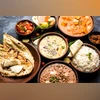“Stinks of curry,” “smells like curry,” and “curry smell” — these phrases have been wielded as shallow insults by British-American influencer Andrew Tate, Donald Trump ally Laura Loomer, Chinese social media users, and countless others. To them, “curry” serves as a pejorative term to denigrate people of Indian origin. But steering away from counter-vitriol, this column focuses on a more enduring aspect: The global journey of curry, from its origins in India to its status as a beloved cuisine worldwide.
The term “Indian curry” is an oversimplification of a diverse cuisine: There is no one “curry”, and no singular spice blend. Curry has evolved across centuries and regions — in Britain and Canada, North Indian flavours are prominent, while South Indian spices are more prevalent in the US and Southeast Asia. The Indian diaspora has further adapted curry in places like Trinidad and Fiji, influenced by regional, caste, and religious backgrounds.
“Caril” or “curry” — likely derived from the Tamil word kari meaning “black”, possibly referring to spiced dishes — entered Portuguese and English cookbooks in the 17th and 18th centuries. However, its roots trace back to the ancient Indus Valley Civilisation. By 2600 BCE, the Harappans were already blending spices like mustard, cumin, and fennel into intricate flavour combinations. Archaeological discoveries, including grinding stones, suggest that even then, meat was being spiced with remarkable sophistication.
Through trade, these culinary techniques spread beyond the Indus Valley. Babylonian tablets from 1700 BCE document recipes for spiced meat sauces, highlighting the early reach of curry’s influence. Far from disappearing, the people of the Indus Valley migrated, carrying their culinary traditions with them. By the Vedic period (1700–500 BCE), spices like fennel and mustard were integral to Indian cooking, evolving into regional specialties over centuries.
Spice cultivation, from black pepper to turmeric, boomed in India, attracting global trade and expanding its culinary repertoire. Greek ethnographers like Megasthenes were captivated by Indian feasts overflowing with spiced meats and rice. Curry-like dishes are mentioned in Indian texts as early as the 4th century BCE. Kautilya’s Arthashastra describes a sauce-based dish made with fresh meat, oil, curds, and pungent spices.
The arrival of coconuts in India, brought by Austronesian traders between 600–300 BCE, significantly influenced South Indian cuisine. In Kerala, coconut became a key ingredient in fish curries and vegetable stews, complementing Indian spices. Indian traders carried their spice knowledge to Southeast Asia, where countries like Thailand and Malaysia adapted them to local ingredients, creating their own distinct curries. Archaeological findings in Vietnam from the 2nd–3rd centuries provide evidence of early Indian-inspired curry in Southeast Asia. In the 12th century, Manasollasa described curries as thick sauces made with sour gruel, curds, rock salt, ginger, coriander, cumin, and black pepper. Though the term “curry” wasn’t yet used, the dish’s regional diversity was evident in the many names it went by: Vyanjana, kaai- kari, and puligari. As curry spread across the world, its popularity was fuelled by Arab traders who introduced Indian spices to West Asia and North Africa. The introduction of South American chillies transformed the way curry was prepared: After settling in Tamil regions, the Portuguese sparked a “post-chilli” revolution, spreading the cuisine’s influence to Europe, Japan, China, and East Africa, where it reshaped local culinary traditions.
And then came the British. Robert Clive’s battalion brought the Tamil “curry” to Bengal, and as the British Empire expanded, curry’s influence reached British kitchens. After the abolition of slavery in 1833, the British transported thousands of Indians to various parts of the world, including Malaysia, Mauritius, Guyana, and the Caribbean, where they infused local cuisines with Indian flavours.
Sake Dean Mahomed opened the UK’s first Indian curry house, Hindoostane Coffee House, in Westminster in 1810. By the 1820s, curry had transitioned from being an Indian colonial dish to a British household item, with curry powders appearing in commercial advertisements.
In subsequent years, British curry evolved further. Bengali immigrants, who arrived in large numbers after the 1970s, and Indian Gujaratis from East Africa, transformed British curry from a simple black-pepper dish to a more complex, chilli-infused creation. In 2001, then British Foreign Secretary Robin Cook declared Chicken tikka masala — a creamy, tomato-based curry — Britain’s national dish.
Whether being used as a racist slur or emerging as a global staple, curry’s journey exemplifies its cultural significance. Each variation, from Indian to Jamaican, reflects a shared history of culinary creativity and cultural exchange, proving just how powerful food can be in bringing people together.
Unlock 30+ premium stories daily hand-picked by our editors, across devices on browser and app.
Pick your favourite companies, get a daily email with all news updates on them.
Full access to our intuitive epaper - clip, save, share articles from any device; newspaper archives from 2006.
Preferential invites to Business Standard events.
Curated newsletters on markets, personal finance, policy & politics, start-ups, technology, and more.



)